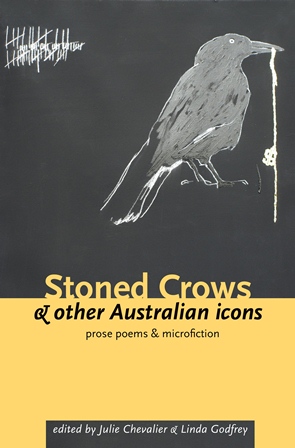Stoned Crows & other Australian icons Launched by Newtown Review of Books
As Linda Funnell said, it’s great that small presses like Spineless Wonders will take the risk on these utterly local pieces, edgy as many of them are. Microfiction has established its own space since the days when people like Vicki Viidikas and Anna Couani were considered highly experimental, with what John Tranter so descriptively calls these ‘splinters’ of prose, splinters that hook and snag at the reader’s imagination using language and images that will instantly resonate with the Australian reader.
Only a few minutes to discuss 46 pieces, so I have made up some general categories and some lists of the specifics they include.
The themes divide loosely into terminology, the sense of place, nostalgia, popular activities, institutions/personalities/landmarks and flora & fauna, all employing the vernacular in not always ironic ways. It’s interesting that as a culture that prides itself on being iconoclastic we should have so many loving evocations of our familiar icons. But there’s an underlying and I think shared social and political consciousness here so that familiar objects and symbols are deconstructed, adapted and transformed, some of them mocked and derided and some of them celebrated in new ways.
We’ll all be familiar with the Australian-specific terminology here – bum cracks, chooks, cockies (the birds, not the roaches) and barbies.
Place is very important to this collection – and specific places are described from Townsville through Byron Bay to Sydney and Melbourne and Port Macquarie, and others around and in between. And although this new generation of writers strongly acknowledges our urban nature, there is still a harking back to the icons of the bush and the outback as well as a trip to a possible future. Landmarks include the Bridge, Circular Quay, Luna Park, and of course Uluru. I was interested to note there were no ‘big’ things – what about the giant potato at Robertson? The big merino? The giant prawn? Perhaps these could be considered for the next volume.
Familiar fauna appears – kangaroos, wallabies, koalas, cockatoos, brolgas, Phar Lap, the funnel-web spider and the brown snake. And, of course prawns and crocodiles. I didn’t notice much flora – just the odd casuarina and mangrove, though you could perhaps include the Hills Hoist, our national tree, here transformed into a poetic image of shapes and meaning.
In fact the transformations of iconic cliche into something new and freshly interpreted is one of the charms of the book – Bunnings as a site for sexual fantasy (I imagine the Bunning sausage sizzle is also a peculiarly Australian way of claiming the space) – the Opera House as an operating theatre, a road train like a gigantic mechanical animal, reminiscent of the sandworms of Dune.
Institutions and iconic figures appear – the ABC and Harold Holt – with the many, particularly Australian, resonances his name evokes – who could ever forget that photo of the chubby balding man in his SCUBA gear? The ANZACs get a mention, both as biscuits and as soldiers, as do lamingtons and Vegemite. Many of our pastimes are referred to – sport, surfing, barbies, agricultural shows, Sculpture by the Sea.
Interestingly, imported items are included – Coke, Bunnings and McDonald’s, for example, are adopted and adapted, reinterpreted as belonging to our own landscape. Is this a case of us being brainwashed by the forces of international capitalism or cheeky examples of post-colonialist satire? You could certainly make that argument for the way we infantalise the monolithic MacDonald’s into the rather fondly patronising Maccas.
Sometimes serious, sometimes humorous, provocative, self-reflective and self-satirising, nostalgic, angry, sad, poetic and personal, realist and stream of consciousness, this collection is above all a celebration of the many things Australia can mean to us, not in a jingoistic way, or even particularly patriotically, it’s a celebration of particular moments in time and space that are virtually untranslateable to those who haven’t grown up with them. For example, I defy any non-Australian to make head or tail of the first piece – Peter Lack-Lewinsky’s ‘iconostasis’, and it doesn’t get much easier after that … I say this with the sort of smugness with which we watched the Olympic opening ceremony. This is our stuff – outsiders, live with it.
Stoned Crows & other Australian icons is a lucky dip full of small delights for the reader and we congratulate everybody involved.

